Distinguishing Lab Diamonds from Natural Diamonds
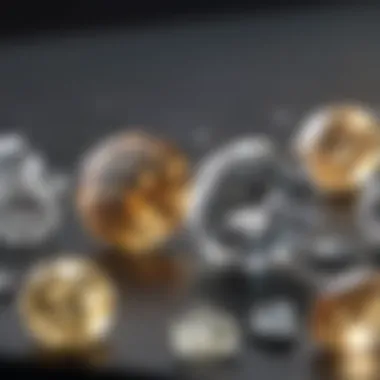
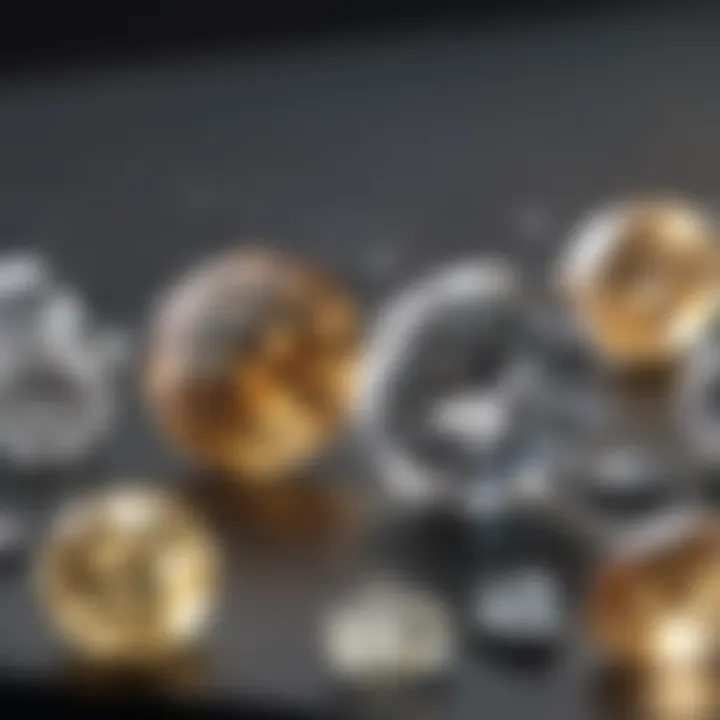
Intro
In a world where innovation meets tradition, the gemstone industry stands at a fascinating crossroads. The allure of diamonds, whether lab-grown or natural, captivates not just collectors and enthusiasts, but also casual buyers looking for the perfect sparkle. Understanding the differences between these two types of diamonds is crucial, not only for making informed purchasing decisions but also for embracing a broader perspective on gemstone value and sustainability.
This exploration will illuminate the unique characteristics that set lab diamonds apart from their natural counterparts, delve into their origins, properties, and the ongoing shift in consumer perceptions. Moreover, this article will reflect on market trends that influence today’s diamond purchases and what that means for the future of the industry.
Equipped with a solid foundation of knowledge, gem aficionados and potential buyers can navigate the intricate landscape of diamonds with clarity and confidence.
Gemstone Overview
Definition and Origins
Diamonds, as most know, are crystalline forms of carbon. Natural diamonds are formed deep within the Earth over the span of millions to billions of years, subjected to high pressure and temperature. In contrast, lab-grown diamonds are created through human intervention, using advanced technologies like High Pressure High Temperature (HPHT) or Chemical Vapor Deposition (CVD). These methods replicate the natural processes in a controlled environment, yielding gemstones that are chemically and physically identical to those mined from the ground.
"While both types of diamonds share the same carbon structure, their journeys from inception to market are vastly different."
Historical Significance
The allure of natural diamonds goes back thousands of years, captivating cultures and fostering myths and legends. From their use in royal crowns to their portrayal as symbols of love and eternity, natural diamonds hold a unique place in history.
On the other hand, lab diamonds, a more recent phenomenon, burst onto the scene in the late 20th century as technological advancements made producing these stones feasible. Their rise reflects a shift in consumer values, sparking debates about ethics, sustainability, and the definition of value in luxury goods.
Gemstone Properties
Hardness and Durability
Diamonds are renowned for their exceptional hardness, rated a perfect 10 on the Mohs scale. This property applies equally to both lab-created and natural diamonds, making them highly durable choice for jewelry. The toughness they exhibit ensures they withstand the rigors of daily wear, making them a popular option for engagement rings and other cherished heirlooms.
Color and Clarity
Both lab diamonds and natural diamonds can exhibit a wide range of colors, from colorless to shades of yellow, brown, and even rare colors like blue and pink. Typically, lab diamonds can be manufactured to reduce flaws and achieve higher clarity levels, which might appeal to some buyers. However, many appreciate the unique characteristics and inclusions found in natural diamonds, which can serve as a testament to their authenticity and age.
This combination of color and clarity plays a significant role in the evaluation and pricing of both lab and natural diamonds. Understanding these aspects is essential for consumers looking to make educated choices.
In summary, comprehending the distinctions between lab-grown and natural diamonds is not merely a matter of preference; it's about appreciating the stories, values, and implications embedded in each stone. As we proceed, we will更加深入地探讨 identity methods and market trends, enriching your understanding of these remarkable gems.
Preamble to Diamonds
Diamonds have long been revered as symbols of beauty, strength, and luxury. The fascination with these gemstones transcends mere aesthetics; diamonds carry a deep significance woven into the fabric of culture, history, and identity. Understanding diamonds, whether they are natural or lab-grown, provides a foundation for appreciating their unique characteristics and implications on personal and societal levels.
The demand for diamonds is not just about their physical properties, but also about the stories they tell, from romantic gestures to ancestral heirlooms. In discussing diamonds, we dive into more than just minerals; we explore elements that reflect human emotions, milestones, and ethical considerations.
Understanding Diamond Composition
At the most fundamental level, diamonds are composed primarily of carbon atoms—each arranged in a crystal structure that gives these gems their remarkable hardness and brilliance. The way these carbon atoms bond creates a lattice structure that refracts light beautifully, resulting in that dazzling sparkle we associate with diamonds. This structure is not exclusive to natural diamonds but is also found in lab-grown counterparts.
Natural diamonds, with their unique growth conditions deep within the Earth, often contain trace elements that influence color and clarity, whereas lab diamonds are produced under controlled environments, creating an opportunity for advanced customization that may not exist in nature. This composition is essential in the differentiation between the two types of diamonds.
From a scientific standpoint, lab diamonds boast the same physical and chemical characteristics as their natural counterparts. This has led to debates around their value and place in the jewelry market. Are they truly equal, or is there an inherent worth in the natural formation process?
Historical Significance of Diamonds
Historically, diamonds have been revered, worshipped, and even considered sacred. They have adorned the crowns of kings, served as tokens of love, and stood against the test of time as coveted treasures. The historical significance of diamonds comes from their rarity and the mystical qualities attributed to them throughout various cultures.
From ancient India where diamonds were mined from riverbeds, to the modern-day labs that create them, the evolution of diamonds parallels advancements in technology and value systems. In centuries past, owning a diamond was an exclusive privilege. Now, the changing dynamics of production and consumer perceptions steadily shape the diamond landscape.
"Diamonds are not just stones; they represent history, tradition, and a journey through time."
In summary, comprehending diamonds encompasses more than just their chemical makeup and origins. It involves looking at their role in society and the evolving narratives surrounding them. As we explore the nuances of lab diamonds versus natural diamonds, we uncover deeper insights into the choices we make and the implications these choices hold. Whether as a consumer, enthusiast, or designer, knowledge about diamonds not only enhances our appreciation but also guides our purchasing decisions.
The Origins of Diamonds
Understanding the origins of diamonds is crucial for anyone looking to comprehend the intrinsic values and attributes of these precious stones. The origins not only influence the diamond's price but also its ethical background, uniqueness, and marketability. As consumers become more educated about their options, knowing whether a diamond is lab-grown or natural can impact purchasing decisions and consumer perception. Each origin distinctly shapes the diamond’s value, utility, and emotional significance, making this an essential facet of our analysis.
Natural Diamond Formation
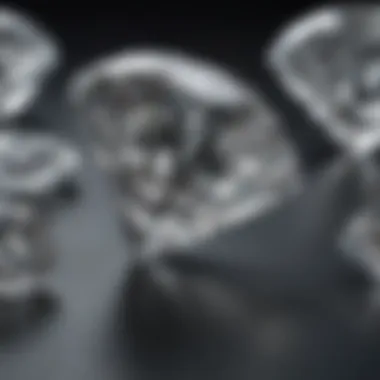
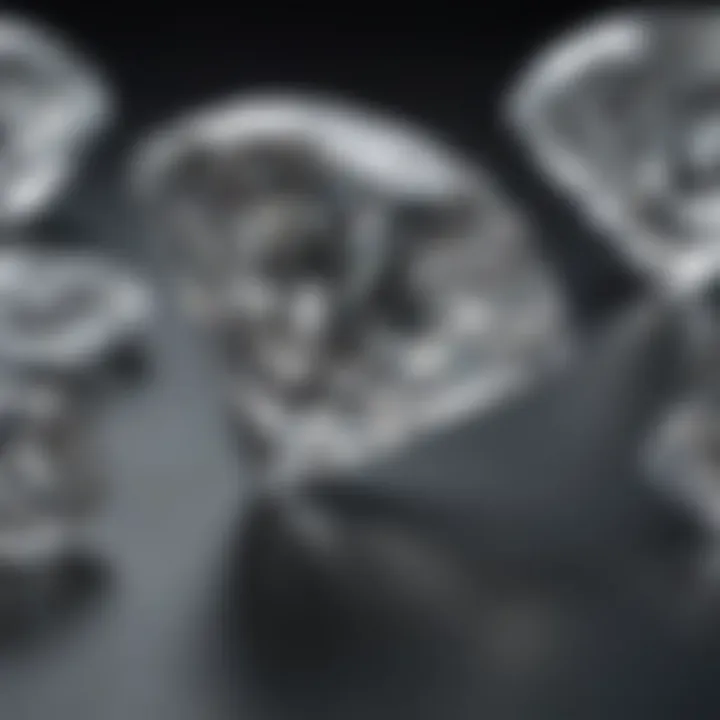
Geological Processes
Natural diamonds are born deep within the Earth, usually about 150 to 200 kilometers below the surface. The geological processes involved in their formation include extreme heat and pressure over millions of years. Carbon atoms bond in a unique crystalline structure, resulting in the hardness and brilliance we associate with diamonds today.
The natural path of diamond formation is remarkable because it encompasses a journey through time and geology. Typically, the heat must reach around 1,300 to 2,500 degrees Fahrenheit, while the pressure needs to be 725,000 pounds per square inch. This incredible demand for conditions creates a key characteristic—natural origin. This aspect alone makes natural diamonds a coveted choice for many.
The unique feature of geological processes lies in how, under specific circumstances, diamonds rise to the Earth’s surface through volcanic eruptions. This not only distinguishes them but also presents challenges for finding and mining. While natural diamonds possess a history that tells a story spanning epochs, they are also subject to environmental impacts and ethical considerations during extraction, which can be seen as a downside in some contexts.
Time Frame of Formation
The time frame of formation for natural diamonds varies significantly but can take anywhere from one to a few billion years. This extensive period contributes to their allure, as these gems carry the weight of millennia within them. The geological events that transport diamonds closer to the surface often happen after such a long time, adding an additional layer of rarity.
One key characteristic of this lengthy process is the long-lasting nature of the stones once they make their way to market. Many buyers appreciate the idea that they own something formed during the Earth’s history, which lends emotional depth to their purchase. However, the undeniable tax on the environment from mining and the ethical dilemmas associated with conflict diamonds cannot be overlooked and often casts a shadow over the natural diamond's charm.
Lab Diamond Creation Techniques
High Pressure High Temperature (HPHT)
The High Pressure High Temperature (HPHT) technique mimics the natural processes that create diamonds, using immense pressure and high temperatures to create diamond from carbon. This method can produce diamonds that are virtually indistinguishable from their natural counterparts in terms of chemical composition and physical properties.
One of the most notable characteristics of HPHT diamonds is their cost-efficiency compared to mined ones. As technology advances, the costs associated with creating these lab diamonds continue to decline, making them an increasingly attractive option for consumers who want quality without the hefty price tag of natural diamonds.
However, the process does have its unique downsides. While the environmental impact is significantly lower than that of natural diamond mining, some purists still question the authenticity of lab-grown diamonds. Despite their strong resemblance to natural ones, some buyers prefer to know the history and the ‘human’ touch that comes with a natural diamond's formation.
Chemical Vapor Deposition ()
The Chemical Vapor Deposition (CVD) method employs a more modern approach to diamond creation. Here, a gas mixture containing hydrogen and a carbon source is heated, allowing carbon atoms to deposit on a substrate, forming a diamond crystal. This method is particularly attractive for its precision and ability to create high-quality diamonds with fewer inclusions.
What sets CVD diamonds apart is their controlled growth environment, facilitating the creation of larger and higher-quality gems. This level of control translates into diamonds that often exhibit fewer flaws than their natural counterparts, making them a popular choice among jewelry designers.
Despite this, the CVD approach may not produce the same natural inclusions that some buyers seek in a diamond. For some, these imperfections tell a story, offering a glimpse into the stone's journey and authenticity. Thus, while the CVD method holds many advantages, the lack of unique inclusions can render these diamonds less desirable for those who value the narrative that comes with natural formations.
Physical and Chemical Properties
Understanding the physical and chemical properties of diamonds is of paramount importance in distinguishing between lab-grown and natural diamonds. The characteristics of the gemstone influence not only its appearance but also its value and marketability. When one talks about diamonds, aspects like brilliance, hardness, inclusions, and flaws come to the forefront. These distinctive qualities help gemologists and consumers alike to make informed decisions and discern between diamonds of different origins.
Evaluating Hardness and Brilliance
Diamonds, known for their extraordinary hardness, rank the highest on the Mohs scale, sitting at a solid ten. This exceptional durability makes them an attractive choice for jewelry. However, it’s not merely this resilience that captivates diamond enthusiasts; its brilliance—the way light interacts with the stone—creates magic that fascinates many.
When evaluating diamonds, one mustn’t overlook how lab-grown diamonds possess this same level of hardness and brilliance as their natural counterparts. Due to the controlled environment in which they are cultivated, lab diamonds can exhibit an impressive clarity and light performance. Nevertheless, buyers should heed that the skill of the cutter also plays a significant role in enhancing these characteristics. A well-cut diamond, whether lab or natural, will refract light exquisitely.
- Key Points to Remember:
- Both lab and natural diamonds are exceptionally hard, rated at ten on the Mohs scale.
- Brilliance can be highly dependent not just on the diamond's origin but on the skill of workmanship involved in cutting the stone.
Differences in Inclusions and Flaws
Inclusions and flaws can tell a compelling tale about a diamond's journey. Natural diamonds often have unique imperfections born from their long and tumultuous formation under the earth’s crust. These inclusions are like fingerprints—distinct and definitive—highlighting each diamond's history.
In contrast, lab diamonds, created within a much shorter time frame, may exhibit fewer inclusions or different types. They can sometimes present what are termed as "growth lines" or specific metallic inclusions, which could be mistaken for imperfections. As a potential buyer, it's crucial to familiarize oneself with these features, as they significantly influence not just the diamond's aesthetic but its overall value.
- Common Inclusions in Natural Diamonds:
- Inclusions Often Found in Lab Diamonds:
- Crystals of other minerals
- Bubbles or gas inclusions
- Internal graining
- Overlapping growth lines
- Metallic inclusions from the manufacturing process
"Understanding inclusions is essential. They often reveal the story behind a diamond’s existence, guiding buyers towards making a well-informed choice."
Being conscious of these differences and embracing the unique traits of each type of diamond can enhance one’s appreciation for these remarkable stones. Educating oneself on both the physical and chemical properties will serve well in navigating the complex landscape of diamond purchasing.
Tools for Identification
Understanding the means by which one can distinguish between lab diamonds and natural diamonds is crucial in the overarching conversation about these gems. The identification process not only aids in ensuring authenticity but also deepens the buyer's awareness regarding the value of their purchase. Given the surge in demand for both types of diamonds, the ability to use effective tools for identification is more pertinent than ever. It allows consumers to make informed decisions, protecting themselves from potential fraudulent sales and supporting ethical purchases. A comprehensive grasp of the necessary tools paves the way for a smoother buying process while enhancing the overall appreciation for these remarkable stones.
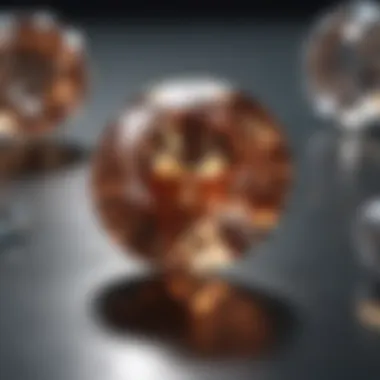
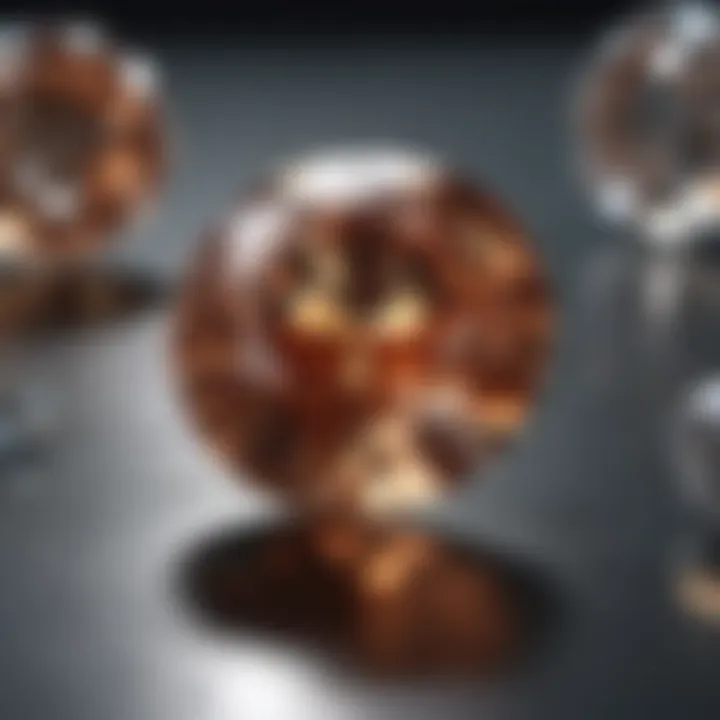
Gemological Instruments
Microscopes
Microscopes play a pivotal role in the analysis and identification of diamonds. Their primary contribution lies in enabling gemologists to scrutinize the internal structure of a diamond. This examination helps observers to spot inclusions and other notable features that reveal a stone's origins. One of the key characteristics of microscopes is their ability to magnify objects, making even the tiniest details visible. This makes it a beneficial choice in the article since understanding these nuances can be the difference between a lab diamond and a natural one.
A unique feature of microscopes is their varying levels of magnification, which can range from low to high. This flexibility offers gemologists the best chance to investigate different characteristics effectively. However, it is worth mentioning that the type of microscope used can present some drawbacks; for instance, a lower-quality microscope may not provide enough detail for accurate identification.
Spectroscopes
Spectroscopes are another essential tool in the identification toolkit. They serve to analyze the light spectrum emitted or absorbed by a diamond. This analysis can disclose crucial information about the stone's chemical composition and formation conditions. A key characteristic of spectroscopes is their unique ability to identify specific wavelengths of light, which can indicate whether a diamond is natural or lab-grown. This makes it a popular choice for experts in the field.
What sets spectroscopes apart is that they can provide a more detailed examination of diamonds compared to just visual tools. However, they also have their downsides. For example, spectroscopes often require a certain level of expertise to interpret the data accurately. If not handled correctly, there can be risks of misidentification, thus complicating an already delicate process.
Expert Analysis Methods
Diamond Certification
Diamond certification involves a comprehensive evaluation of a diamond's various characteristics by a recognized gemological laboratory. This certification is a critical aspect as it establishes authenticity and provides a standardized quality assessment. The key characteristic of diamond certification is its detailed report, which includes essential information such as carat weight, clarity, color, and cut. This document becomes increasingly beneficial when navigating the market, giving buyers confidence through verified data.
One unique feature of diamond certification is the presence of unique identification numbers, often inscribed on the diamond’s girdle. This allows the diamond to be traced back to its report, enhancing its security. On the flip side, certification can incur additional costs, which some potential buyers may view as a disadvantage. However, the peace of mind it affords is often worth the expense for many.
Professional Appraisal
A professional appraisal serves another layer of certainty in the diamond purchasing process. This method involves hiring a qualified gemologist or appraiser to evaluate a diamond's overall quality and market value. Highlighted is the reliability that comes with a professional's trained eye; their expertise plays a vital role in confirming the diamond's nature—whether lab-grown or natural. The subjective insights offered by seasoned appraisers can be beneficial, particularly for collectors or enthusiasts who require a thorough inspection.
One of the unique features of professional appraisals is the personalized attention the appraiser provides. Unlike standardized certificates, appraisals consider market trends and personal preferences, tailoring advice accordingly. However, cautions must also be made because the quality of appraisers can vary. An inexperienced appraiser may lead to misjudgments, making it essential for buyers to seek professionals with strong reputations.
Consumer Perception and Market Trends
Understanding consumer perception and market trends around diamonds, specifically lab-grown and natural diamonds, is crucial for anyone interested in the gemstone industry. Recent shifts in attitudes can greatly influence purchasing decisions, brand loyalty, and overall market dynamics. This section examines how various factors — including ethical considerations, technological advancements, and economic influences — shape the public’s view of diamonds.
Public Attitudes Towards Lab Diamonds
The perception of lab diamonds has changed significantly over the past decade. Once viewed with skepticism, they are now considered a viable alternative to natural diamonds. Some consumers see them as guilt-free gems that spark joy without the ethical baggage associated with some natural diamonds. Others, however, remain loyal to natural stones due to traditional views and the belief in their unique story.
The varying attitudes can be attributed to a few core factors:
- Ethical Concerns: Many consumers are concerned about the origins of their jewelry. Lab diamonds present an eco-friendly alternative, as they do not contribute to the environmental degradation often tied to diamond mining.
- Affordability: Pricing is a significant factor. Lab diamonds typically cost less than their natural counterparts, making them appealing for budget-conscious buyers.
- Quality Perception: While lab diamonds are chemically identical to natural diamonds, some consumers doubt their worth, thinking they lack the same allure. This perspective is steadily changing as education about their properties improves.
Market Growth and Trends
Sales Statistics
Sales statistics reveal an interesting aspect of the diamond market’s evolution. In recent years, the popularity of lab diamonds has surged, leading to impressive revenue growth within this segment. Research indicates:
- Sales of lab diamonds have increased by over 20% annually in certain markets.
- Natural diamond sales, while still strong, have shown signs of plateauing, with fluctuations influenced by consumer interest in ethical sourcing.
The rise in lab-grown diamond sales indicates a growing acceptance and trust in this alternative. This is especially true among younger demographics, who further prioritize sustainability.
Future Projections
The future projections for the diamond market suggest continued growth for both lab-grown and natural diamonds, albeit in different trajectories. With lab diamonds becoming mainstream, industry analysts predict several trends:
- Technological Advancements: As technology for producing lab diamonds improves, we can expect better quality and a larger variety of stones.
- Consumer Education: Efforts to educate consumers about the benefits of lab diamonds are likely to continue, helping to demystify them.
- Diverse Offerings: Jewelers may expand their offerings, showcasing a broader range of lab diamonds, including unique cuts and colors — something that might not be readily available in natural diamonds.
"The rise of lab diamonds signifies not merely a shift in consumer preference, but also a broader glimpse into evolving societal values around sustainable practices."
Through understanding these dynamics, buyers can navigate their choices with more clarity, making decisions that align with personal ethics and lifestyle preferences.
Ethical Considerations
When diving into the world of diamonds, the conversation increasingly steers toward the ethical ramifications surrounding their acquisition. Ethical considerations encompass different angles, spanning from the origins of diamonds to the impact on communities and ecosystems. Understanding these aspects is essential for a well-rounded perspective, especially for consumers who value moral integrity alongside beauty and rarity.
With lab diamonds gaining popularity, they introduce a significant shift in this narrative. Although beautiful, the traditional natural diamonds—often pulled from remote and conflict-affected regions—have a tainted reputation. Buyers are more aware now than ever about the journey of their chosen gemstone.
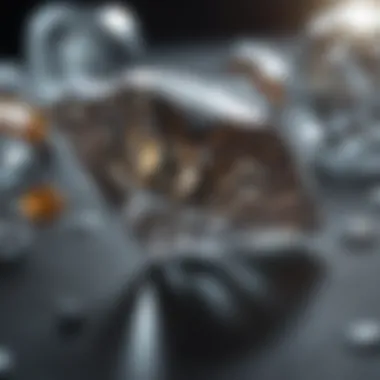
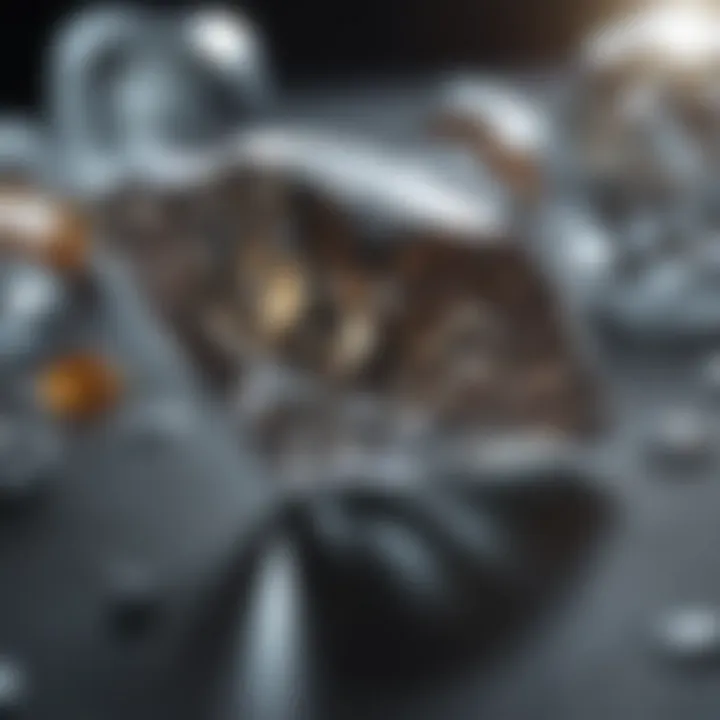
Conflict-Free Identification
Conflict-free identification has indeed become a crucial criterion in today's market for diamonds. The term refers to diamonds harvested without contributing to armed conflict or human rights violations. Traditional diamond mining has allegedly supported wars and unethical labor practices in certain parts of the globe; thus, organizations like the Kimberley Process emerged to combat this issue.
However, while this initiative provided some semblance of regulation, the effectiveness of such measures remains under scrutiny. The ever-present risk of synthetic covering—where natural diamonds are labeled as conflict-free—can create confusion for buyers. Emphasis on education about these origins is paramount.
"In the diamond industry, transparency is the golden key to consumer trust."
Consumers can enhance their understanding of conflict-free diamonds by looking for certification from reputable organizations, which assures that their purchases have not funded violence or oppression.
Sustainability of Lab Diamonds
On the other hand, when it comes to sustainability, lab diamonds bring a breath of fresh air. These gems are created in controlled environments, thus sparing the earth from being torn apart for their extraction. Considering pressing concerns about resource depletion and environmental damage, lab-grown diamonds stand out as an eco-friendly alternative.
These diamonds generally require less energy to produce when compared to their natural counterparts. Their crafting processes—be it through High Pressure High Temperature (HPHT) or Chemical Vapor Deposition (CVD)—not only mitigate environmental damage but also promise minimal carbon footprints.
While individual manufacturers claim to follow ethical practices, transparency remains the linchpin that can further bolster the sustainability argument. Consumers seeking lab diamonds should look up their source, ensuring that their choices reflect their values.
Guidelines for Purchasing Diamonds
When it comes to purchasing diamonds, both lab-grown and natural, it’s crucial to have a comprehensive set of guidelines that can steer potential buyers in the right direction. The significance of these guidelines cannot be underestimated; they equip buyers with the necessary knowledge to make informed choices that align with their personal values and budgetary constraints. Knowing what to look for can mean the difference between a regrettable purchase and an investment that truly shines.
Each buyer's taste will vary, but ensuring awareness of various factors, such as diamond types, quality characteristics, and ethical implications, is essential. Moreover, it's important to consider where to make such purchases. The landscape is wide, with both online retailers and local jewelers offering myriad options to fit each individual's preferences.
Factors to Consider
Before diving into the pool of options, buyers should take a moment to reflect on several pivotal factors:
- Budget: Establish how much you’re willing to spend. Diamonds can vary greatly in price based on size, quality, and origin.
- Purpose: Be clear whether the diamond is for an engagement ring, an investment, or a personal piece. This will help guide selections.
- Certification: Look for diamonds that come with a grading report from a reputable gemological institute. These reports ensure authenticity.
- Personal Preferences: Understand what features are important to you, like cut, clarity, color, and carat weight.
Taking each of these factors into account provides a solid foundation for a successful purchase.
Trusted Sources for Purchase
Finding trustworthy sources is another cornerstone of smart diamond buying. Here’s a closer look at the two most common avenues: online retailers and local jewelers.
Online Retailers
Online retailers have revolutionized the diamond buying experience. With thousands of options available at the click of a button, shoppers can easily compare prices and characteristics from the comfort of their home. A significant characteristic of online retailers is their often lower pricing compared to physical stores due to reduced overhead costs. Moreover, many platforms provide extensive educational resources, allowing buyers to understand the specifics of their choices. However, a potential pitfall is the inability to physically inspect a stone before purchasing, which can make it difficult to gauge its true appearance and quality firsthand.
Unique Advantage: The sheer breadth of inventory available online means buyers can access a larger selection, which can aid in finding the perfect stone that adheres to their criteria. On the downside, returning unwanted purchases can become a cumbersome task depending on the retailer's policies, which merits careful reading before checking out.
Local Jewelers
On the flip side, local jewelers present a more tactile approach to diamond buying. Shoppers have the benefit of seeing and touching diamonds in person, allowing them to scrutinize each stone's characteristics up close. Trustworthiness often accompanies local shops, especially those with established reputations in the community. The personal touch—like the ability to ask questions and receive tailored advice—is hard to find online.
Key Characteristic: Local jewelers can frequently provide a more personalized service, helping customers navigate the complexities of diamond purchasing. They might also offer unique, one-of-a-kind pieces that aren’t available in larger online stores. Yet, prices can be higher than online options due to the overhead costs associated with physical retail space.
In summary, buyers must weigh the advantages and disadvantages of each option, considering their own needs and preferences to make the most informed decision. Whether opting for the convenience of online shopping or the personal touch of local jewelers, each route has its merits and challenges.
Finale: Making Informed Decisions
When it comes down to selecting a diamond, be it for an engagement ring or simply as part of a collection, making informed choices is truly paramount. Understanding the nuances between lab-grown diamonds and their natural counterparts can have significant implications, both ethically and financially. The insights presented in this article have hopefully illuminated the critical aspects of what separates these two diamond types, guiding you through the sometimes murky waters of diamond purchasing.
Recap of Key Points
Throughout this article, several key components have been thoroughly discussed to provide a comprehensive understanding of the diamond market:
- Origin: Natural diamonds are formed in the Earth's mantle over billions of years, while lab diamonds can be created in mere weeks through advanced technological methods.
- Properties: Both diamond types share nearly identical physical and chemical properties, making them beautifully similar but fundamentally different in their origins.
- Identification: Understanding the tools and methods of identification is critical. Gemological instruments and expert analysis are essential in distinguishing between the two.
- Consumer Trends: Acknowledging public sentiment toward lab diamonds, as well as exploring the growth trends in the market, provides insight into the evolving diamond landscape.
- Ethical Considerations: The conflict-free nature of lab diamonds appeals to many consumers, offering a greener choice in a world increasingly concerned with ethical sourcing.
Resulting from this knowledge are better purchasing decisions and enhanced personal satisfaction, whichever direction the choice leads. It is worth pointing out that the market is growing rapidly, with more consumers gravitating towards lab-grown options—not solely for their potential cost-effectiveness, but for their ethical appeal.
Encouragement for Research
There’s a treasure trove of information available for anyone eager to dive deeper into the world of diamonds. Whether you are a gemstone enthusiast or a prospective buyer pondering your next investment, researching further can shed light on intricate details that the general discussions might overlook. Here are some avenues to consider:
- Visit Gemological Institutes: Engaging with professionals who categorize and certify diamonds can provide hands-on experience.
- Follow Online Resources: Websites like Wikipedia and Britannica offer extensive articles covering various aspects of diamonds, from geology to market dynamics.
- Join Forums and Communities: Platforms like Reddit are filled with discussions from jewelers, gemologists, and collectors who share first-hand experiences and advice.
- Attend Workshops and Expos: If possible, check out local jewelry exhibitions or workshops to connect with experts and gain practical insights.
The more informed you are about your choices, the better equipped you will be to navigate the options before you. In a realm where beauty meets complexity, taking the time to research thoroughly ensures that you'll make choices that resonate with your values and desires. Understanding the landscape of lab versus natural diamonds is but the first step towards becoming a well-rounded collector or buyer.
"Knowledge is power, particularly when it comes to investing in precious gems. The more you know, the more confident your decision-making will be."



